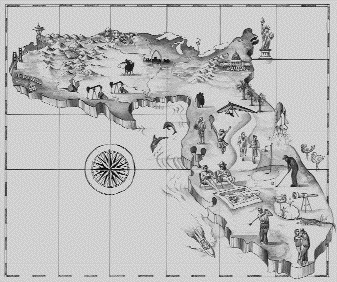
|
| Briefing Book |
| Background Material |

|
| Briefing Book |
| Background Material |
| Social Security in an Aging Society. |
The music of the Rolling Stones and the Doors will pulsate through the
communal dining rooms at assisted living communities and nursing
homes, as 80 year-olds try to remember Woodstock through the haze of
time.
The aging society will seize America, with profound economic,
demographic and cultural consequences.
A few simple numbers illustrate the stark reality. Today, 13 of every
100 Americans are over the age of 65. By the year 2030, perhaps 20 of
every 100 residents of this nation will be 65 and over.
This is unique in human history. Never have so many people lived so
long. Old people have always been around, with the outer limit of
human existence about 120 years. But they were rare: bad sanitation
and diseases killed people, with only a lucky handful getting much
beyond middle age.
An American born in the year 1900 had a life expectancy of 47. Today's
newborns can expect to reach age 76, on average.
The age revolution is accelerating: the baby boom generation, the 76
million persons born in the years 19461964, is the largest cohort in
American history. The boomers' parents married early and had lots of
kids. But the boomers themselves marry late, if at all, and have
smaller families.
That is the reason for the trends that will transform society. Large
numbers of people are growing old, living longer than ever before. Yet
the work force, those whose labor will sustain their elders in
retirement, is growing very slowly.
At the same time, the economy has been mired in a productivity
slowdown for a generation. Despite vast capital investments, and the
universal dissemination of computer technology, the rate of
productivity increase is very small by historical standards.
Therefore, the economic pie - the total output of goods and services
produced by Americans - is expanding slowly. If growth were rapid, we
wouldn't worry as much about meeting the demands of the elderly. But
with the size of the pie expanding sluggishly, we are worried about
the bigger slice the elderly will consume.
The U.S. is living in a calm before the storm. Because birth rates
were low in the Great Depression, the number of people who begin
drawing Social Security and Medicare each year is rising at a modest
pace.
However, the crisis will hit when the masses of baby boomers begin
drawing their benefits. The oldest of them will become eligible for
full Social Security payments in the year 2012, and the ranks of
beneficiaries will then swell by almost four million a year for a
20-year span.
The challenge for society is how to pay for the costs of a huge chunk
of the population that is not working. When people retire at 65, they
can look forward to 15 to 20 years without a job, living on their
pensions, Social Security and savings.
But only half of American workers are covered by private pension
plans, and there is scant likelihood that this figure will improve.
Social Security, therefore, is indispensable.
Individual savings won't be the answer, either. Baby boomers are not
saving enough money. The national rate of personal savings is barely
5%, compared with 12% a generation ago, in 1965. The oldest boomers
are saving a scant one-third of what they would need to maintain their
current standard of living in retirement, according to a Merrill Lynch
study.
We have a 15-year period to discuss, debate and determine changes in
federal policy dealing with Social Security and Medicare before the
crunch hits. That isn't much time for a political system that moves at
a sluggish pace.
"In a worst case scenario, today's retirement promises could not be
afforded without massive harm to the economy," the Hudson Institute
warned in a report. "Painful trade-offs between competing generations
and priorities would become inevitable."
On the medical side, the cost threat is even more ominous. At least
with Social Security, we can make reasonably accurate guesses of wage
growth and the retirement benefits that will be linked to wages.
But medical costs are an unknown. Consider: Medicare was created in
1965, two years before doctors at the Cleveland Clinic performed the
first coronary bypass operation. Today, coronary tests and surgeries,
costing a total of $5 billion per year, make up the biggest single
category of spending in the Medicare budget.
New tests, surgeries and therapies yet undreamed of will add to the
nation's health care bill. The combination of new medical technology
and an aging population adds up to huge spending increases.
Combine new health technology with the increasing frailties of age,
and the result is a spending explosion.
The average health cost for a 40-year old man is $1,900, and $3,067
for a woman of the same age. At age 65, spending jumps to $7,362 a
year for a man, and $6,900 for a woman. At 80-plus, the figures soar
to $16,000 for a man and $13,000 for a woman, according to a study by
Watson Wyatt, a benefits consulting firm.
"The aging of the baby boom generation will deal a staggering blow to
the U.S. health care system," the Watson Wyatt report said.
"Is it fair to ask today's taxpayers to continue funding a Medicare
program that will not be able to furnish comparable benefits when they
become Medicare enrollees?" the study asks.
The fairness issue applies with equal force to Social Security.
"Looking only at what is fair to give Social Security beneficiaries
leaves out the other half of the equation, which is what is fair to
ask other people to pay," said Herbert Stein, a noted economist.
The following is a speculative look at America, the Gray-Haired
Nation of the next century.
 Restaurants throughout the land will serve early bird specials, a buck
off the price of dinner if you eat before 5:30 PM. Cruise lines,
nursing homes and retirement centers will be the Microsofts and Intels
of tomorrow's stock market, avidly watched for each quarter's results.
Restaurants throughout the land will serve early bird specials, a buck
off the price of dinner if you eat before 5:30 PM. Cruise lines,
nursing homes and retirement centers will be the Microsofts and Intels
of tomorrow's stock market, avidly watched for each quarter's results.


When the boomers begin retiring, the real estate market will go into a slump. The boomers may want to retire and move to Florida, Arizona or Colorado, or maybe just across town to a high-rise condo. Home ownership rates just hit a record high, 66% of the adult population.
There won't be enough Generation X couples to buy the homes that their parents, the boomers, built.
America will become increasingly a society of widows. Men are more likely to die younger, and women live longer with chronic diseases. The longevity gap between men and women, about seven years at birth, shows no signs of completely closing. Women have moved into the work force, reached the executive ranks and have access to the high-paid, high stress jobs. But they still are less likely to suffer fatal heart attacks and strokes.
Women, who are 60% of the Medicare and Social Security beneficiaries, will continue to outlive men, the experts believe.
Women have traditionally been the care givers, the ones who stay home
from work to care for children, ailing husbands, parents and in-laws.
With most women working outside the home, who will do the care-giving
work in the next century for the aging population?

There are more than 5 million aging people living in special circumstances. Assisted living - which ranges from fancy apartments to spartan rooming houses - provides accommodations for two million people, those who can care for themselves but need occasional help. Nursing homes house another three million persons, who need medical or custodial care.
This special population could soar to 24 million by the year 2040. Where will the money and the staff come from to care for them?
The graying of America could threaten national security because there will be a severe shortage of young Americans for the armed forces. "The median age of Americans is at its highest point in history," noted Milton R. Copulos, president of the National Defense Council Foundation. "This has grave implications for the nation's defense establishment, ranging from the size of the potential manpower pool, to current retirement policies and provisions for health care," he said.
Workers expect to retire relatively young and enjoy many years without working. The average age for collecting Social Security benefits is currently 63.
"Employers and all levels of government must begin to prepare for a time when workers in general - particularly young, highly skilled and industrious workers - are very likely to be in short supply (except during recessions)," said the Hudson Institute report.
Yet corporate policy is going in the other direction, with layoffs, downsizings, mergers and the growing use of contingent workers. Only a handful of companies make efforts to hire older workers and these are so rare they generate feature stories in newspapers and on television. The corporate world is doing almost nothing for the skilled older worker who, according to many surveys, would like to make a transition to full retirement by working two or three days a week. The worker would get some extra money, and the corporation would have a veteran on the job. This rarely happens.
However, part-time opportunities may increase when businesses run short of skilled workers.
The population will shift significantly. Whites, while still the biggest group, are rapidly aging, and will decline as a share of the total population.
Minority groups, with a younger population and a higher birth rate, will become a bigger share of the total population, and a rapidly growing segment of the work force.
The median age - half older, half younger - is 35 years old for whites, compared with 28 for blacks, 25 for Hispanics, and 29 for other groups (Asians, Native Americans).
By 2050, "the population will be one in which an increasing number of elderly Anglos may be dependent on young minority populations," according to An America Challenged, a population study by Steve Murdock.
All the major industrial nations face the same aging problem as the United States. Nobody knows what will happen to currency exchange rates and flows of capital around the world as the countries devote more of their resources to pay for the retirement and health needs of an aging population. It could mean a slowdown in world trade, with fewer autos, computers and VCRs moving around the world.
Interest rates also could become more volatile. The Japanese, traditionally big buyers of U.S. Treasury securities, will be spending more of their money at home. This could force the Treasury to boost interest rates to attract investors, and the resulting high rates could hamper U.S. economic activity.
This review is an educated guess about the uncertain future. The only thing certain is that we will have legions of the elderly dominating America's economics, politics and culture. As the Beatles once sang, Will you still need me, will you still feed me, when I'm 64?
 |
 |
 |
 |
 |